When someone passes away, the body shows signs like pallor, cooling, and stiffness, indicating natural death. To plan transportation, you’ll need proper legal documents, follow cultural or religious rites, and coordinate with funeral services, ensuring dignity and compliance. Transportation methods vary, from specialized vehicles to aircraft for long distances, often requiring permits. Handling the process with compassion and proper planning helps honor the deceased and support grieving families—exploring these steps in detail can make the process smoother.
Key Takeaways
- Recognize natural post-death signs like skin pallor, rigor mortis, and cooling to confirm death.
- Prepare the body in a suitable casket, ensuring all legal documentation and permits are in order.
- Coordinate with funeral and transportation services early, adhering to legal, cultural, and religious requirements.
- Follow proper handling procedures to maintain dignity, safety, and respect for cultural or religious customs.
- Communicate clearly with family members, providing emotional support and guidance throughout the planning and transport process.
Understanding the Immediate Aftermath of Death
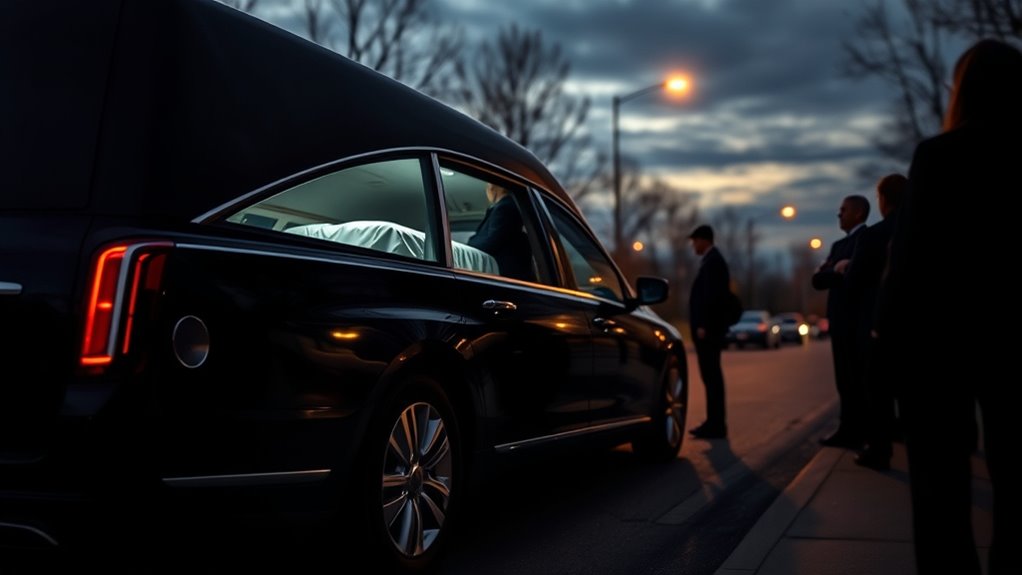
When death occurs, the body’s immediate state begins to change rapidly. You’ll notice the skin may become pale or bluish, and the body starts to cool down as blood circulation ceases. Rigor mortis, the stiffening of muscles, typically sets in within a few hours, making movements difficult. You might observe the eyes becoming cloudy or glassy, and breathing stops entirely. The body’s natural processes begin to break down, leading to decomposition over time. Recognizing these signs helps you understand that death is a biological process, not just an emotional event. It’s essential to approach this phase with compassion and clarity, knowing that these changes are natural and inevitable. Preparing yourself for these signs can ease the emotional burden during this difficult time. Being aware of post-mortem changes can also assist in planning appropriate care and transportation. Additionally, understanding body decomposition processes can help in making informed decisions about timing and procedures for body transportation and final arrangements. Familiarity with biological decay and natural body processes can further guide you in managing the logistics of body handling and preservation.
Common Methods of Transporting the Deceased
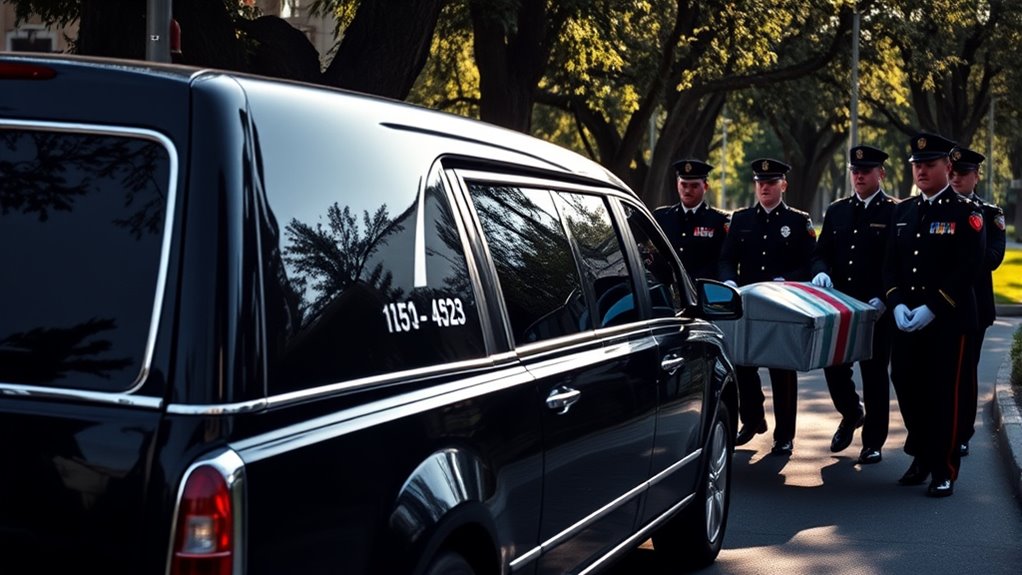
Transporting the deceased is a delicate process that requires careful handling and respect. Typically, the body is placed in a specialized mortuary or transfer casket designed to guarantee dignity and safety. Vehicles like hearse vans are the most common choice for transporting the body from the place of death to a funeral home or morgue. These vehicles are equipped to handle the weight and ensure a smooth ride, minimizing disturbance. In some cases, especially for long distances, the body may be transported by air in a specialized aircraft. Local regulations often dictate specific methods and requirements, so coordinating with funeral directors or transportation services assures proper handling. Respectful, secure, and compliant transport methods are essential to honor the deceased and support the grieving process. Utilizing appropriate transport vehicles ensures the process remains dignified and respectful, and understanding transportation regulations helps prevent logistical issues. Additionally, adhering to funeral transportation standards is crucial for maintaining legal compliance and ensuring a smooth process. Furthermore, being aware of dignified handling practices is vital to uphold respect throughout the transportation procedure.
Cultural and Religious Considerations in After-Death Procedures
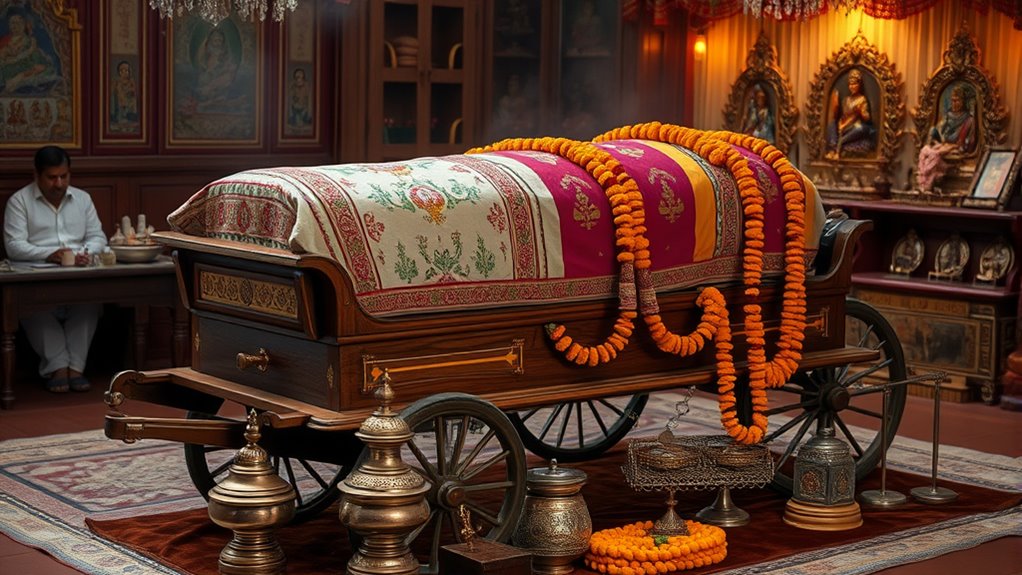
Your understanding of cultural and religious practices is essential when arranging after-death procedures. Different communities have specific rituals and customs that must be observed, and some religions impose restrictions on transport methods. Recognizing these considerations helps ensure respectful and compliant handling of the deceased. Additionally, being aware of home safety and wellness can facilitate a more comfortable environment for grieving families and caregivers during these sensitive times. Cultivating creative practice can also provide emotional support and a sense of connection during times of loss. Understanding foraging ranges can also inform how communities gather natural resources to support traditional rituals and practices. Implementing space and organization strategies can help create a calming environment for families during mourning periods.
Rituals and Customs
Rituals and customs surrounding after-death procedures reflect deeply held cultural and religious beliefs, guiding how communities honor the deceased and support the grieving process. Understanding these practices helps you plan respectful and culturally sensitive transport. Here are key aspects to contemplate:
- Preparation rituals often include washing, dressing, or embalming, respecting tradition and beliefs about purity.
- Funeral ceremonies may involve specific rites like prayers, vigils, or processions that honor the departed.
- Post-funeral customs can include mourning periods, memorial services, or specific handling of remains, aligning with cultural norms.
Respecting these customs ensures dignity for the deceased and comfort for the grieving family while facilitating smooth transportation and handling within cultural expectations.
Religious Restrictions
Have you ever considered how religious beliefs can shape the way communities handle after-death procedures? Religious restrictions can considerably influence transport, embalming, and burial practices. Some faiths require prompt burial, while others may forbid embalming or cremation. Respecting these rules is vital to honoring the deceased and their traditions.
| Religion | Restriction | Practice Impact |
|---|---|---|
| Islam | No embalming; swift burial | Transport must be quick, body untouched |
| Judaism | Avoid cremation; burial within 24 hours | Planning must be prompt and respectful |
| Hinduism | Cremation preferred; avoid embalming | Transport should align with rituals |
Legal and Documentation Requirements
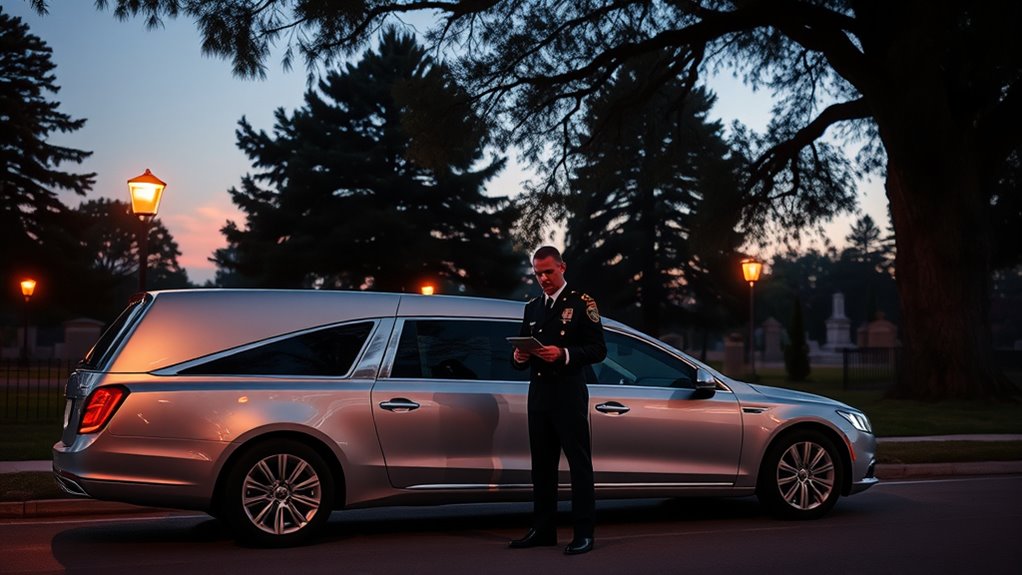
When planning for after-death transport, you need to ensure you have all the necessary legal documentation in order. Understanding international transport regulations is vital if you’re moving a body across borders. Failing to meet these legal requirements can cause delays or complications in the process. Additionally, familiarity with safe handling practices is important to ensure the dignity and safety of the transported body. Being aware of bank SWIFT/BIC codes can be essential when dealing with international payments related to the transport services. Proper documentation also includes verifying the discoloration or separation of the body, which may affect transport procedures. Recognizing the Vetted – Flat Iron Bike standards can help in understanding quality benchmarks for equipment used during transport. Awareness of privacy policies related to sensitive information can also be crucial during such processes.
Necessary Legal Documentation
To guarantee a smooth after-death transfer, you need to gather the necessary legal documentation promptly. Proper paperwork ensures compliance and avoids delays. First, obtain the death certificate, which officially confirms the death and is required for most procedures. Second, secure the cremation or burial permit, depending on your plans, to authorize the final disposition. Third, gather identification and ownership documents, such as the deceased’s ID, will, or estate papers, to facilitate legal transfers. Ensuring these documents are accurate and complete prevents complications during transport and handling. Keep multiple copies handy, and verify their validity before proceeding. Being prepared with all necessary paperwork streamlines the process and respects legal protocols, making the transfer as smooth and efficient as possible.
International Transport Regulations
Managing international transport regulations for human remains requires careful attention to legal and documentation requirements. You must guarantee all paperwork, such as death certificates, embalming certificates, and permits, are correctly prepared and valid for each country involved. Different nations have specific rules about transporting remains across borders, including restrictions on certain embalming methods or containers. You’ll need to liaise with authorities, embassies, and shipping companies to confirm compliance. Failure to meet legal standards can cause delays, fines, or even refusal of transport. It’s essential to stay updated on international laws, as regulations often change. Proper planning and thorough documentation safeguard the process, ensuring respectful and lawful transport of the deceased across borders.
Planning and Coordinating Transportation Arrangements

Planning and coordinating transportation arrangements require careful attention to detail to guarantee a smooth and respectful process. To do this effectively, you should focus on three key steps:
Effective transportation coordination demands meticulous planning and clear communication.
- Verify legal documentation: Ensure all permits, death certificates, and customs papers are in order to avoid delays. Incorporating predictive analytics can help anticipate potential issues based on historical data, streamlining the process further.
- Coordinate with transportation providers: Confirm schedules, vehicle types, and special handling needs well in advance.
- Communicate clearly with all parties: Keep everyone informed about timelines, procedures, and any required actions to prevent misunderstandings. Additionally, understanding fraud prevention tools can help safeguard sensitive information during coordination, ensuring the process remains secure and compliant.
Emotional Support and Practical Tips for Families
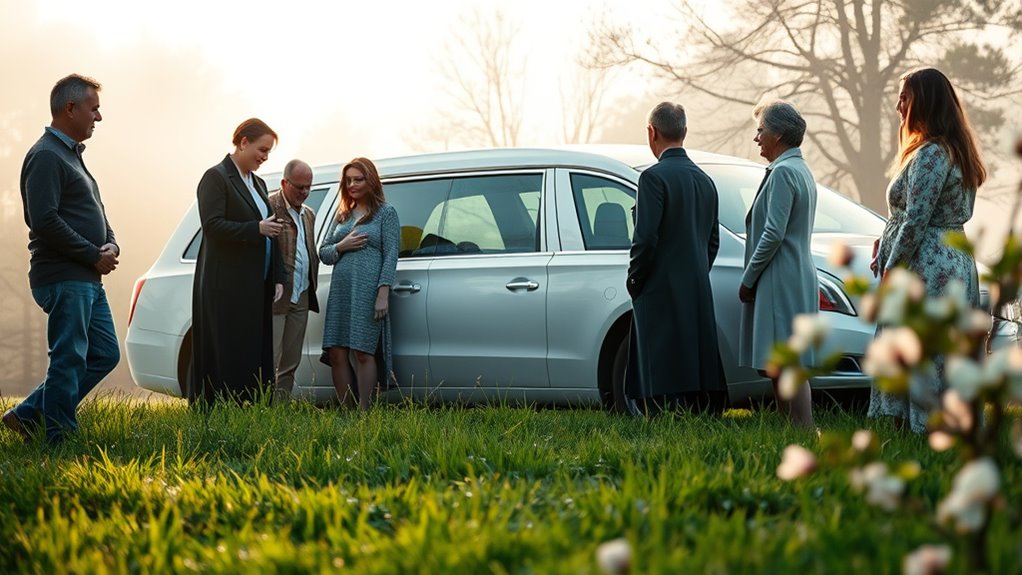
After making transportation arrangements, addressing the emotional needs of family members becomes paramount. Grief can feel overwhelming, so offer reassurance and listen with patience. Encourage open communication and remind loved ones you’re there for support. Practical tips include staying hydrated, taking deep breaths, and allowing yourself time to process. Consider having a trusted friend or counselor nearby for emotional backup. To help, here’s a quick guide:
| Tip | Why it helps |
|---|---|
| Share memories | Keeps loved ones connected |
| Take deep breaths | Reduces anxiety |
| Offer physical comfort | Eases emotional tension |
| Keep essentials handy | Minimizes stress during transit |
| Seek support from professionals | Provides guidance and relief |
Being present and supportive makes a difficult time a little easier. Understanding grief’s impact can help family members navigate their emotions more effectively.
Frequently Asked Questions
How Do Insurance Policies Affect Transportation Options?
Insurance policies can greatly influence your transportation options after death. If your policy covers funeral expenses and transportation, it might cover costs for certain transport methods, making arrangements easier and more affordable. You should review your policy details to understand what’s included. Knowing this helps you plan better and ensures your loved ones aren’t burdened with unexpected expenses or limited transport choices during a difficult time.
What Are the Costs Involved in After-Death Transportation?
You need to take into account the costs involved in after-death transportation, including transportation fees, documentation, and permits. You might face charges for local or long-distance transfers, embalming, and necessary paperwork. You could also encounter expenses for specialized transportation services or arrangements with funeral homes. Planning ahead helps you understand these costs, ensuring you’re prepared financially and can make informed decisions during a difficult time.
Can Family Members Personally Transport the Deceased?
Yes, you can personally transport the deceased, but it’s often complicated. You’ll need to guarantee proper handling, follow legal requirements, and use appropriate vehicles. Check with local authorities and funeral homes for specific regulations. It’s usually recommended to hire professionals who specialize in after-death transport, as they have the experience, equipment, and permits to handle the process safely and respectfully.
How Long Does the Transportation Process Usually Take?
The transportation process usually takes anywhere from a few hours to a day, depending on factors like distance, transportation method, and scheduling. You might experience delays if the death occurs on a weekend or holiday, or if special arrangements are needed. It’s best to stay in contact with the funeral home or transportation service to get updates and plan accordingly, ensuring a smooth passage for your loved one.
Are There Environmental Considerations in Transportation Methods?
You should consider environmental factors when planning transportation, as some methods have a bigger impact than others. For example, ground transport using traditional fuel-powered vehicles produces emissions, while eco-friendly options like electric hearses or biodiesel vehicles reduce your carbon footprint. Opting for greener transportation not only helps the environment but also aligns with sustainable practices, making the process more respectful and responsible during difficult times.
Conclusion
Thinking ahead guarantees you’re prepared when it matters most. Just like a captain charts a course before the storm, planning your loved one’s after-death transport brings clarity and peace. Remember, over 70% of families find comfort knowing they’ve arranged these steps in advance. By understanding the process and considering cultural or religious needs, you can navigate this challenging time with confidence, turning uncertainty into a steady, guiding light for your family’s journey ahead.









